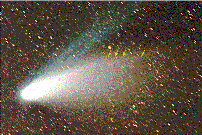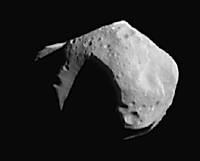Click on image for full size
NASA
NEAR Flyby of Asteroid Mathilde
News story originally written on July 3, 1997
On June 27, 1997, the NEAR spacecraft passed very close to the asteroid Mathilde. NEAR stands for Near Earth Asteroid Rendevous.
Mathilde is a large asteroid. Its diameter was estimated to be 60 km. That is about 600 football fields across! This makes it the most massive asteroid yet to be visited by a spacecraft.
Mathilde is also unique because it has an extremely long period of rotation. In fact, scientists have said that it hardly moves! It takes 17.5 days for Mathilde to rotate just once on its own axis.
The NEAR spacecraft has found five craters over 20 km across (or 200 football fields across) on the surface of Mathilde. No evidence of water has been found.
You might also be interested in:

NASA has chosen CONTOUR as the next mission in its Discovery Program. CONTOUR stands for the Comet Nucleus Tour. CONTOUR will explore at least three comets by flying very close to them. At one point, CONTOUR
...more
It was another exciting and frustrating year for the space science program. It seemed that every step forward led to one backwards. Either way, NASA led the way to a great century of discovery. Unfortunately,
...more
The Space Shuttle Discovery lifted off from Kennedy Space Center on October 29th at 2:19 p.m. EST. The weather was great as Discovery took 8 1/2 minutes to reach orbit. This was the United States' 123rd
...more
A moon was discovered orbiting the asteroid, Eugenia. This is only the second time in history that a satellite has been seen circling an asteroid. A special mirror allowed scientists to find the moon
...more
Will Russia ever put the service module for the International Space Station in space? NASA officials want an answer from the Russian government. The necessary service module is currently waiting to be
...more
A coronal mass ejection (CME) happened on the Sun early last month. The material that was thrown out from this explosion passed the ACE spacecraft. The SWICS instrument on ACE has produced a new and very
...more
J.S. Maini of the Canadian Forest Service called forests the "heart and lungs of the world." This is because forests filter air and water pollution, absorb carbon dioxide, release oxygen, and maintain
...more















